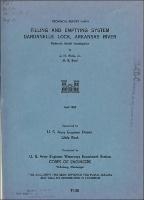Please use this identifier to cite or link to this item:
https://hdl.handle.net/11681/13696Full metadata record
| DC Field | Value | Language |
|---|---|---|
| dc.contributor | United States. Army. Corps of Engineers. Little Rock District | - |
| dc.contributor.author | Ables, Jackson H. | - |
| dc.contributor.author | Boyd, M. B. (Marden B.) | - |
| dc.contributor.author | U.S. Army Engineer Waterways Experiment Station | - |
| dc.contributor.author | Hydraulics Laboratory (U.S.) | - |
| dc.date.accessioned | 2016-08-18T19:15:33Z | - |
| dc.date.available | 2016-08-18T19:15:33Z | - |
| dc.date.issued | 1969-04 | - |
| dc.identifier.uri | http://hdl.handle.net/11681/13696 | - |
| dc.description | Technical report | - |
| dc.description | Abstract: Dardanelle Lock will be 110 ft wide by 670 ft long and will provide a maximum lift of 54 ft. Results of model tests to determine the suitability of a longitudinal floor culvert filling and emptying system for the lock are presented herein. The recommended system includes intake manifolds in the approach walls, a 14.5-ft-wide by 13-ft-high culvert in each wall, a lateral crossover culvert at the midpoint of the lock leading to four 15-ft-wide by 8-ft-high longitudinal floor culverts, and culvert outlets located riverward of the lock in a common basin. Each floor culvert has nine pairs of 1.57-ft-wide by 4-ft-high side ports spaced 16 ft on centers, resulting in a port-to-culvert area ratio of 0.94. The port manifolds in each end of the lock cover 19 percent of the chamber iength and are centered-at the upstream and-downstream quarter points of the lock chamber. Baffles were used along the center line of the lock and along lock walls opposite port manifolds. With the recommended arrangement the lock can be filled in 8.4 min with a maximum longitudinal hawser stress of about 5.2 tons and emptied in 9.9 min with a maximum hawser stress of about 3.5 tons with normal two valve operation using a 1-min valve opening time. Baffles are effective in reducing bottom water movement toward the ends of the lock and in reducing individual boils and turbulence so that turbulence conditions in the lock chamber are satisfactory during normal operation. Pressures downstream from filling valves drop low enough during the valve opening period (about -2 ft of water) that air venting is recommended to eliminate the possibility of cavitation damage. Performance of the system during single valve operation was not as favorable as desired. It was necessary to use an 8-min valve opening time (18.2-min filling time) to obtain acceptable hawser stresses and reasonable pressures downstream from filling valves. Air venting also is needed during this type of operation. | - |
| dc.publisher | Hydraulics Laboratory (U.S.) | - |
| dc.publisher | U.S. Army Engineer Waterways Experiment Station. | - |
| dc.relation | http://acwc.sdp.sirsi.net/client/en_US/search/asset/1041382 | - |
| dc.relation.ispartofseries | Technical report (U.S. Army Engineer Waterways Experiment Station) ; H-69-5. | - |
| dc.rights | Approved for public release; distribution is unlimited. | - |
| dc.source | This Digital Resource was created from scans of the Print Resource | - |
| dc.subject | Arkansas River | - |
| dc.subject | Culverts | - |
| dc.subject | Dardanelle Lock (Ark.) | - |
| dc.subject | Hydraulic models | - |
| dc.subject | Locks (Hydraulic structures) | - |
| dc.subject | Dardanelle Lock and Dam (Ark.) | - |
| dc.subject | Hydraulic structures | - |
| dc.title | Filling and emptying system, Dardanelle Lock, Arkansas River : hydraulic model investigation | - |
| dc.type | Report | en_US |
| Appears in Collections: | Technical Report | |
Files in This Item:
| File | Description | Size | Format | |
|---|---|---|---|---|
| TR-H-69-5.pdf | 1.36 MB | Adobe PDF |  View/Open |